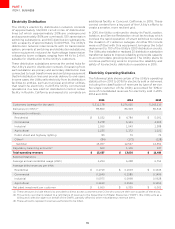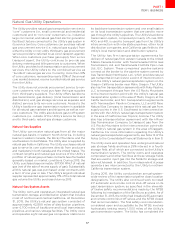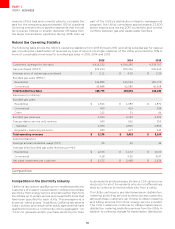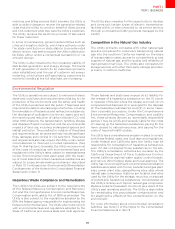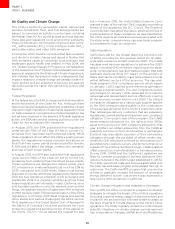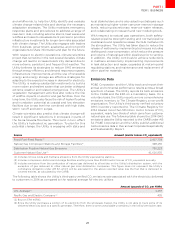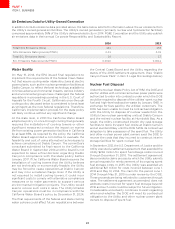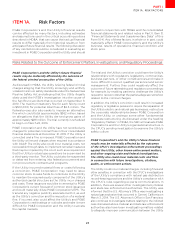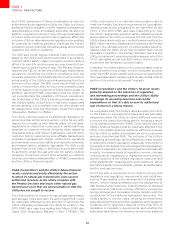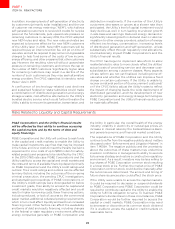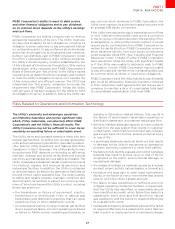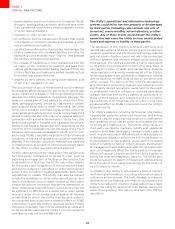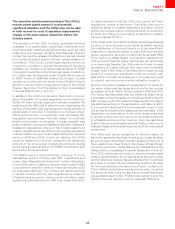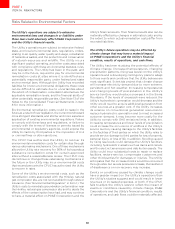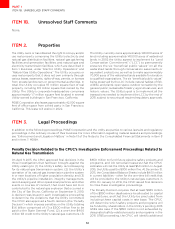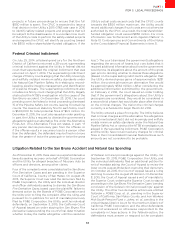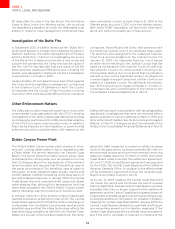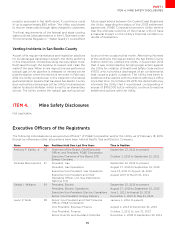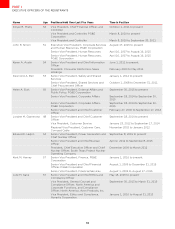PG&E 2015 Annual Report Download - page 34
Download and view the complete annual report
Please find page 34 of the 2015 PG&E annual report below. You can navigate through the pages in the report by either clicking on the pages listed below, or by using the keyword search tool below to find specific information within the annual report.
26
PART I
ITEM 1A.RISK FACTORS
In addition, increasing levels of self-generation of electricity
by customers (primarily solar installations) and the use
of customer net energy metering (“NEM”), which allows
self-generating customers to receive bill credits for surplus
power at the full retail rate, puts upward rate pressure on
remaining customers. In January 2016, the CPUC adopted
new NEM rules and rates. The new rules and rates are
expected to become eective for new NEM customers
of the Utility later in 2016. New NEM customers will be
required to pay an interconnection fee, will go on time of
use rates, and will be required to pay some non-bypassable
charges to help fund some of the costs of low income,
energy eciency, and other programs that other customers
pay. However, the resulting rules will still put upward rate
pressure on remaining customers, and remove the cap on
the number of NEM customers. Significantly higher rates
for remaining customers may result in a decline of the
number of such customers as they may seek alternative
energy providers. The CPUC states that it intends to revisit
these rules in 2019.
A confluence of technology-related cost declines
and sustained federal or state subsidies could make
a combination of distributed generation and energy
storage a viable, cost-eective alternative to the Utility’s
bundled electric service which could further threaten the
Utility’s ability to recover its generation, transmission, and
distribution investments. If the number of the Utility’s
customers decreases or grows at a slower rate than
anticipated, the Utility’s level of capital investment would
likely decline as well, in turn leading to a slower growth
in rate base and earnings. Reduced energy demand or
significantly slowed growth in demand due to customer
migration to other energy providers, adoption of energy
ecient technology, conservation, increasing levels
of distributed generation and self-generation, unless
substantially oset through regulatory cost allocations,
could adversely impact PG&E Corporation’s and the
Utility’s financial results.
The CPUC has begun to implement rate reform to allow
residential electric rates to more closely reflect the utilities’
actual costs of providing service and decrease cost-
subsidization among customer classes. Many aspects
of rate reform are not yet finalized, including time-of-
use rates and whether the utilities can impose a fixed
charge on certain customers. If the Utility is unable to
recover a material portion of its procurement costs and/
or if the CPUC fails to adjust the Utility’s rates to reflect
the impact of changing loads, the wide deployment of
distributed generation, and the development of new
electricity generation and energy storage technologies,
PG&E Corporation’s and the Utility’s financial results could
be materially aected.
Risks Related to Liquidity and Capital Requirements
PG&E Corporation’s and the Utility’s financial results
will be aected by their ability to continue accessing
the capital markets and by the terms of debt and
equity financings.
PG&E Corporation and the Utility will continue to seek funds
in the capital and credit markets to enable the Utility to
make capital investments, pay fines that may be imposed
in the future, and incur costs to meet the Penalty Decision’s
requirement to incur costs of up to $850 million for safety-
related projects and programs to be identified by the CPUC
in the 2015 GT&S rate case. PG&E Corporation’s and the
Utility’s ability to access the capital and credit markets and
the costs and terms of available financing depend primarily
on PG&E Corporation’s and the Utility’s credit ratings and
outlook. Their credit ratings and outlook can be aected
by many factors, including the outcomes of the on-going
criminal prosecution, the pending CPUC investigations,
and ratemaking proceedings. If PG&E Corporation’s or
the Utility’s credit ratings were downgraded to below
investment grade, their ability to access the capital and
credit markets would be negatively aected and could
result in higher borrowing costs, fewer financing options,
including reduced, or lack of, access to the commercial
paper market, additional collateral posting requirements,
which in turn could aect liquidity and lead to an increased
financing need. Other factors can aect the availability
and terms of debt and equity financing, including changes
in the federal or state regulatory environment aecting
energy companies generally or PG&E Corporation and
the Utility in particular, the overall health of the energy
industry, volatility in electricity or natural gas prices, an
increase in interest rates by the Federal Reserve Bank,
and general economic and financial market conditions.
The reputations of PG&E Corporation and the Utility
continue to suer from the negative publicity about matters
discussed under “Enforcement and Litigation Matters” in
Item 7. MD&A. The negative publicity and the uncertainty
about the outcomes of these matters may undermine
investors’ confidence in management’s ability to execute
its business strategy and restore a constructive regulatory
environment. As a result, investors may be less willing to
buy shares of PG&E Corporation common stock resulting
in a lower stock price. Further, the market price of PG&E
Corporation common stock could decline materially after
the outcomes are determined. The amount and timing of
future share issuances also could aect the stock price.
If the Utility were unable to access the capital markets,
it could be required to decrease or suspend dividends
to PG&E Corporation and PG&E Corporation could be
required to contribute capital to the Utility to enable the
Utility to fulfill its obligation to serve. To maintain PG&E
Corporation’s dividend level in these circumstances, PG&E
Corporation would be further required to access the
capital or credit markets. PG&E Corporation may need
to decrease or discontinue its common stock dividend
if it is unable to access the capital or credit markets on
reasonable terms.


